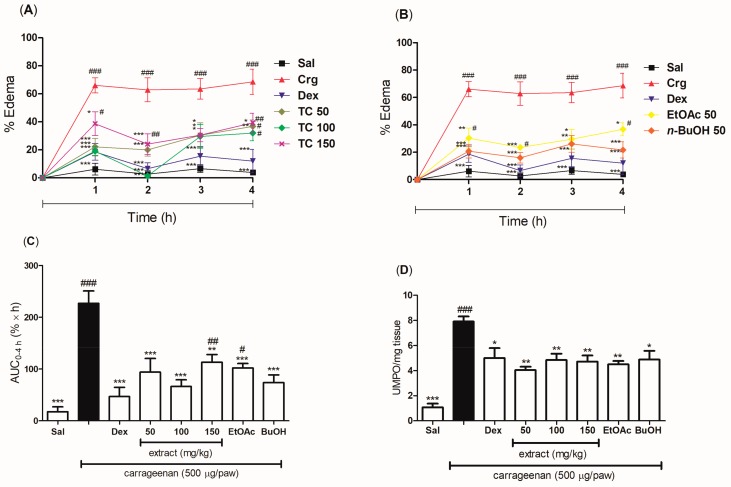Figure 3.
Evaluation of the anti-inflammatory effect of the pretreatment with the hydroethanolic extract and the ethyl acetate (EtOAc) and n-butanol (BuOH) fractions of T. catharinensis leaves in the carrageenan-induced paw edema model. BALB/c mice were treated orally with saline, the hydroethanolic extract at doses of 50, 100, or 150 mg/kg, the EtOAc and BuOH fractions at a dose of 50 mg/kg, and dexamethasone at 2 mg/kg. The edema was measured at different time points (1, 2, 3, and 4 h) after the administration of λ-carrageenan (500 μg/paw). After 4 h, the paw was removed and the enzymatic activity was measured. One unit of myeloperoxidase (MPO) activity (UMPO) was defined as the degradation of one micromole of peroxide per minute. (A) Percentage of edema (0–4 h) in mice pretreated with the hydroethanolic extract; (B) Percentage of edema (0–4 h) in mice pretreated with the EtOAc and BuOH fractions; (C) Area under the curve (AUC) for the percentage of paw edema as a function of time (0–4 h) in mice pretreated with the hydroethanolic extract and fractions; (D) MPO activity in paw tissues of mice pretreated with the hydroethanolic extract and fractions. ### p < 0.001, ## p < 0.01, and # p < 0.05 compared with the group treated with saline; *** p < 0.001, ** p < 0.01 and * p < 0.05 compared with the carrageenan group. Sal: saline (0.9 mg/mL); Crg: carrageenan (500 µg/paw); Dex: dexamethasone (2.0 mg/kg); TC 50: T. catharinensis extract (50 mg/kg); TC 100: T. catharinensis extract (100 mg/kg); TC 150: T. catharinensis extract (150 mg/kg); EtOAc 50: ethyl acetate fraction (50 mg/kg); BuOH 50: 𝑛-butanol fraction (50 mg/kg).

